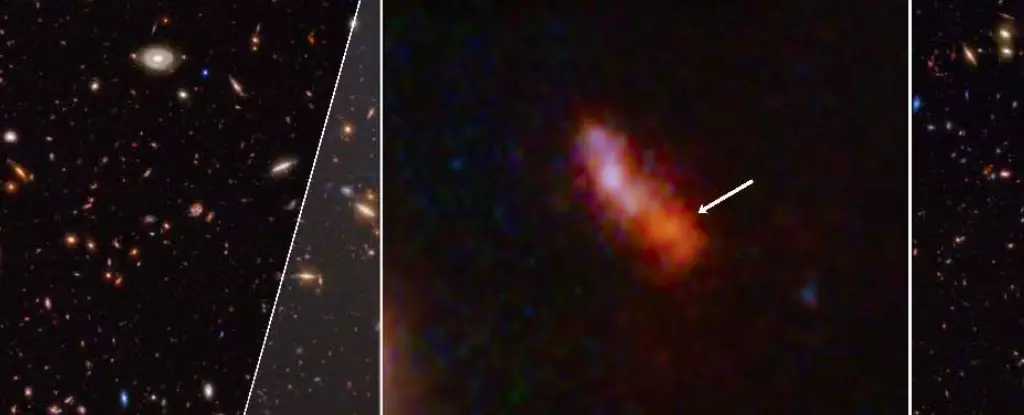The astronomical community is buzzing with excitement following the latest revelations from the James Webb Space Telescope (JWST). This groundbreaking instrument has shattered previous limitations on our understanding of the early Universe, detecting light from a galaxy known as MoM-z14, which existed a mere 280 million years after the Big Bang—a feat previously thought insurmountable. Until the advent of the JWST, the available technology, notably represented by the Hubble Space Telescope and the Spitzer Space Telescope, failed to unveil the complexity of galaxies from so long ago. Hubble’s modest 2.4-meter mirror and the Spitzer’s 85 cm mirror were insufficient to peer deeply into the infrared realms required to capture the faint light of these ancient formations.
With its expansive 6.5-meter mirror and state-of-the-art detectors, the JWST has exploited advancements in technology, overcoming the veil that has long obscured our view of the early cosmos. Within just weeks of initiating observations, it began revealing a trove of luminous galaxies at redshifts exceeding z=10, dramatically altering previous assumptions about galaxy formation during the Universe’s formative years. The initial findings have been electrifying, providing fresh perspectives on how galaxies coalesced and evolved within the first several hundred million years post-Big Bang.
MoM-z14: A Cosmic Breakthrough
The newly discovered MoM-z14 is the centerpiece in this astonishing exploration. As outlined in a recent paper submitted to the Open Journal of Astrophysics, reports indicate that MoM-z14 operates at a redshift of 14.4, signifying its incredible distance and the light’s long journey through the fabric of time and space. This discovery presents a pivotal moment in cosmology, challenging existing theories on the frequency of early galaxies. Researchers anticipated an insignificant number of galaxies from this epoch, yet JWST’s observations have presented an unexpected abundance, invigorating discourse on galactic assembly and early star formation.
The paper’s lead author, Rohan Naidu from MIT, articulates how JWST’s findings have opened new frontiers, pushing the observational limits further back than ever before. Rather than a mere scientific curiosity, this research explores fundamental questions and provides insights into the nuanced evolution of the Universe.
The Chemistry of Cosmic Formation
What sets MoM-z14 apart is not merely its distance but its distinctive chemical composition. Initial spectroscopic assessments reveal that its light primarily emanates from stars, suggesting the absence of a significant active galactic nucleus (AGN)—often considered a hallmark of galaxy formation. Instead, researchers posit that MoM-z14 hosts luminous supermassive stars, aligning with theoretical predictions about conditions in the early Universe.
The nitrogen-to-carbon ratio in MoM-z14 appears higher than that observed in our own Sun, providing key indicators regarding its chemical history. This compelling similarity in composition between MoM-z14 and ancient globular star clusters within the Milky Way suggests a cosmic connection, hinting at shared environments for star formation across billions of years. It emphasizes the pivotal role of chemical enrichment and nucleosynthesis in sculpting our Universe’s fabric.
Linking Morphology to Evolutionary Pathways
An intriguing observation from the JWST’s findings is the morphological diversity displayed among these ancient galaxies. Researchers categorize them largely into point sources and extended forms, with evidence hinting at a relationship between their shapes and chemical makeup. Notably, the study suggests that these morphological traits may reflect different evolutionary pathways—a connection previously unexamined. The notion that morphology can provide insight into chemical abundance opens avenues to deepen our understanding of galactic evolution.
This complexity does not just stop at defining galaxies but provokes questions about their future. Certain ancient galaxies, such as those exhibiting strong nitrogen emissions, could represent a unique class that further challenges existing paradigms. The newfound understanding of these nitrogen-rich objects throws into sharp relief the intricate interplay of chemistry and morphology, suggesting a more layered narrative of our cosmic origins.
The Future of Cosmic Exploration
The JWST has ignited a renaissance in cosmology, promising a cascade of discoveries waiting to unfold. As more galaxies from this extraordinary era are unveiled, a clearer picture of the evolution of cosmic structures will emerge. The anticipated launch of the Roman Space Telescope could bolster these findings, presenting opportunities for comprehensive datasets and deeper analyses that enrich our understanding of the cosmos.
While the JWST stands at the forefront of uncovering cosmic mysteries, it epitomizes a broader vision of scientific exploration. It serves as a testament to human ingenuity, demonstrating our relentless pursuit of knowledge and understanding of the Universe. No longer are we shackled by the limitations of previous telescopes; the JWST beckons us forward, inviting a deeper exploration into the origins of galaxies, stars, and the very fabric of existence itself. It is this pursuit of probing the unknown that truly defines the frontier of modern astrophysics.


Leave a Reply